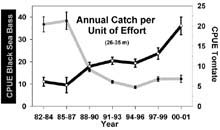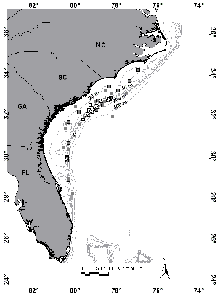
The Warsaw grouper is one of many formerly abundant fish species that have become increasingly rare due to unchecked overfishing. Click image for larger view.
Reef Fishes: Important and Vulnerable Fishery Species
George R. Sedberry
Senior Marine Scientist, Marine Resources Research Institute, SCDNRHuman consumption of fish has increased dramatically in the last several decades, due to increases in human population, per-capita consumption of seafood, and advances in fishing technology. Reef fishes such as those that occur on the reefs being explored during this mission appear to be particularly at risk, and many species are severely overfished or in danger of being so. Warsaw grouper and speckled hind, formerly common groupers on shelf-edge reefs, are increasingly rare. The fishery for red porgy was closed in 1999 because of extremely low population levels. The economic and ecological value of these species makes protecting the sustainability of the fishery a critical consideration for this region.
In addition to reduced populations of top-level predators, community structure changes have been observed in reef-fish communities, as predator-prey relationships are disrupted by overfishing. There is evidence that this is occurring, as the relative abundance of fishery species declines, while less economically desirable species increase in abundance. Because fishery and non fishery species may feed very differently, such fishing-induced changes probably affect benthic prey communities found on reefs and adjacent sandy bottoms.

Annual catch per trap (CPUE) in fish trap survey for black sea bass and tomtate. Black sea bass is an important fishery species and tomtates are of little economic value. There appears to be a shift in community dominance from black sea bass to tomtate. Click image for larger view.
Many economically important reef fishes share a suite of life history and behavioral characteristics that make them particularly susceptible to overexploitation. These characteristics include long life, large adult size, late maturity, sex reversal from female to male with increasing size and age, and spawning in aggregations and/or at sites that are predictable in time and location. Predictable spawning aggregations are particularly well-documented in tropical reef fishes, and the negative impacts of fishing these aggregations are well-known. Although some studies have presented evidence for spawning aggregations of gag on temperate reefs of the Gulf of Mexico, it is uncertain if such aggregations represent a major regional spawning ground, as has been documented for some tropical groupers, and what the effects might be of fishing such aggregations if they do. There are few data available on spawning locations, times and behavior of reef fishes off the southeastern Atlantic coast, but there is some circumstantial evidence for aggregations of some species. Circumstantial evidence includes long-distance migration of these species. These migrations sometimes coincide with the spawning season, and are thought to be movements toward pre-spawning aggregations or movements to actual spawning sites. However, migration patterns and behavioral or other reproductive impetus for movements are not well understood.
Additional circumstantial evidence for spawning aggregations of gag, scamp and other reef fishes includes concentrations of fish in spawning condition at specific depths such as deep shelf edge reefs. Such concentrations might represent spawning aggregations, or they might represent movements of larger, and therefore sexually mature, fish into deeper water, as has been shown for other fishes. As in the Gulf of Mexico, there has historically been more concentrated fishing effort along those deeper (150-300 ft) reefs during grouper spawning seasons. If these are spawning aggregations that are being targeted, such fishing can have deleterious effects, because fish are often caught prior to spawning, and fishing might disrupt spawning behavior.

Locations of capture of scamp during the spawning season (gray squares) and capture of scamp in spawning condition (white circles). Click image for larger view.
Spawning aggregations in reef fishes are believed to correspond spatially and temporally with hydrographic features that insure greatest survival of early life-history stages. For this reason, many species utilize the same locations for spawning, even at different times of the year. These hydrographic features are often associated with prominent bottom features that influence circulation near (and downstream from) the spawning banks. Many reef fishes with pelagic eggs and larvae spawn in the vicinity of gyres near the shelf edge. These circular water movements induced by bottom features are implicated in the removal of pelagic eggs from the spawning site, thus reducing predation. Such gyres may carry eggs and larvae away from predators on the reef, or toward ideal post-larval settlement habitat, or toward areas of high larval fish food production.
Along the continental shelf edge off the southeastern Atlantic coast, temporary and semi-permanent gyres and upwellings are associated with high nutrient levels and plankton productivity. Such intermittent upwellings might coincide with reef-fish spawning locations. The presence of high nutrients at the shelf edge, and a gyre-driven mechanism to transport larvae from shelf-edge spawning to estuarine nursery habitats, influences recruitment success in gag. Recruitment in gag and some other fishes is correlated with the location, strength and persistence of gyres, and it is likely that spawning of gag and other reef fishes off the Carolinas, Georgia and northern Florida is timed and located to take maximum advantage of the intermittent and permanent gyre formation and upwelling of nutrients along the edge of the continental shelf.
During exploration of shelf-edge reefs, we will map bottom features and oceanographic features such as upwelling areas, and observe fish to determine if spawning is occurring. We hope to measure physical conditions, such as bottom type and circulation, that result in the formation of aggregations of spawning fishes, so that such aggregations can be managed for sustained fisheries.
Sign up for the Ocean Explorer E-mail Update List.














































